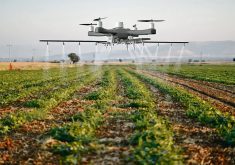When a law becomes widely perceived as unreasonable or unenforceable, people will increasingly ignore it. That appears to be happening with drone spraying.
Only a handful of products are registered for application via drone in Canada, and none of those are agricultural products. Despite this, all indications point to an increase in the farm use of drones for spray applications.
Drones have many other farm uses — from checking crops to checking cows to monitoring watering systems — but many drones are set up for the express purpose of spraying, and they’re being promoted as such.
Read Also

Proactive approach best bet with looming catastrophes
The Pan-Canadian Action Plan on African swine fever has been developed to avoid the worst case scenario — a total loss ofmarket access.
Not too many farmers would replace their high clearance sprayer with drones at this point, but the machines are certainly useful for spot applications of product and for spraying hard-to-access areas. Some believe they could eventually take a chunk of the high clearance sprayer market.
Unfortunately, registration of crop protection products does not seem imminent. Many unanswered questions remain regarding swath width, evenness of disposition and efficacy. Companies seem hesitant to seek drone registrations, knowing they’ll have to stand behind the performance of their products with this new application method.
The United States has largely taken a different route, with anything registered for aerial application also allowed for drone application. People selling drones in Canada can only look south with envy.
No one knows the extent of unregistered drone applications in Canada, but most agree it’s growing. While it’s technically illegal, the Pest Management Regulatory Agency is apparently turning a blind eye. To date, no PMRA actions have been reported.
Saskatchewan Pulse Growers is running a radio ad reminding producers that drone application is illegal and that it may have ramifications for the sale of pulse crops. Concern over market acceptance is always important, but worrying about drones would seem to be a stretch.
If a product is registered on a crop and if the maximum residue limit is not exceeded, it’s hard to imagine an international buyer being concerned about whether the product was applied by ground, aircraft or drone. Buyers will quite often want a declaration that only registered products were applied, but I’ve never seen them ask how it was applied.
Walking through the Cypress Farm and Ranch Show in Medicine Hat last month, I had a person from a drone company approach me and claim he was going to publicly flaunt the law in an attempt to trigger action from the PMRA.
He wants to see the issue go to court because he believes the PMRA will have trouble arguing that drone application is fundamentally different from aerial application.
Remember the height of the debate over the monopoly export powers of the Canadian Wheat Board? Farmers who trucked even a tiny amount of their wheat into the U.S. were charged and some even went to jail.
The law was upheld in the strictest sense to stop a trickle of illegal exports from becoming a stream and then a torrent, but the publicity put a spotlight on the issue. Years later, public and farmer sentiment had shifted, and the CWB’s monopoly powers were removed.
The passion over drone spraying is nowhere near that intense, but it’s growing. Will the PMRA eventually clamp down and try to make an example of someone? Will legality eventually be decided in a courtroom?
Stay tuned. This issue may only be simmering now, but it’s likely to grow hotter as more farmers decide to use drones for spray operations.


















